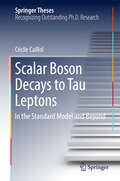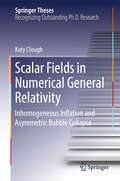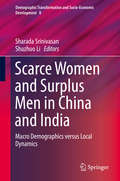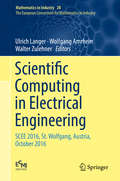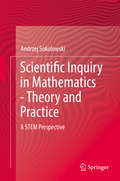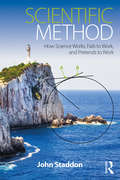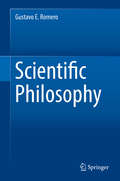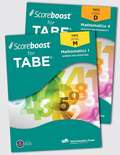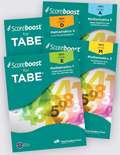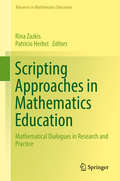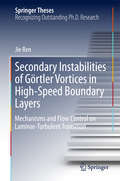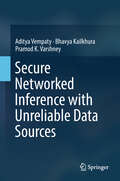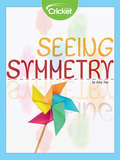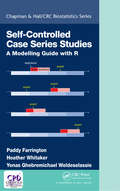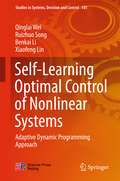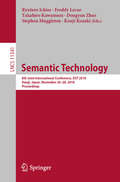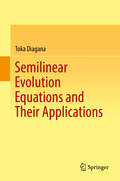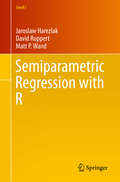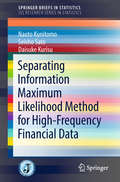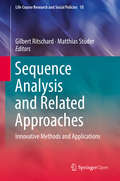- Table View
- List View
Scalar Boson Decays to Tau Leptons: in the Standard Model and Beyond (Springer Theses)
by Cécile CaillolThis thesis presents a study of the scalar sector in the standard model (SM), as well as various searches for an extended scalar sector in theories beyond the SM (BSM). The first part of the thesis details the search for an SM Higgs boson decaying to taus, and produced by gluon fusion, vector boson fusion, or associated production with a vector boson, leading to evidence for decays of the Higgs boson to taus. In turn, the second part highlights several searches for an extended scalar sector, with scalar boson decays to taus. In all of the analyses presented, at least one scalar boson decays to a pair of taus. The results draw on data collected by the Compact Muon Solenoid (CMS) detector during proton–proton collisions with a center-of-mass energy of 7 or 8 TeV.
Scalar Fields in Numerical General Relativity: Inhomogeneous Inflation and Asymmetric Bubble Collapse (Springer Theses)
by Katy CloughThis book explores the use of numerical relativity (NR) methods to solve cosmological problems, and describes one of the first uses of NR to study inflationary physics. NR consists in the solution of Einstein’s Equation of general relativity, which governs the evolution of matter and energy on cosmological scales, and in systems where there are strong gravitational effects, such as around black holes. To date, NR has mainly been used for simulating binary black hole and neutron star mergers like those detected recently by LIGO. Its use as a tool in fundamental problems of gravity and cosmology is novel, but rapidly gaining interest. In this thesis, the author investigates the initial condition problem in early universe cosmology – whether an inflationary expansion period could have “got going” from initially inhomogeneous conditions – and identifies criteria for predicting the robustness of particular models. State-of-the-art numerical relativity tools are developed in order to address this question, which are now publicly available.
Scarce Women and Surplus Men in China and India
by Sharada Srinivasan Shuzhuo LiThis volume documents how families, communities and some groups (single men, young 'scarce' women, parents) adapt and adjust to recent demographic shifts in China and India. It discusses how demographic change interacts with other processes of change, including changes with respect to economic development and globalization, gender, class, caste, families, migration and work. The chapters offer micro-level analyses contextualized in larger processes of change and push further existing understandings of the consequences of the demographic imbalance between men and women in China and/or India, particularly from a gender perspective. As such this book will be of interest to scholars and students in population studies, sociology, international development, gender studies, and Asian studies.
Scientific Computing in Electrical Engineering: Scee 2016, St. Wolfgang, Austria, October 2016 (Mathematics In Industry Ser. #28)
by Ulrich Langer Wolfgang Amrhein Walter ZulehnerThis collection of selected papers presented at the 11th International Conference on Scientific Computing in Electrical Engineering (SCEE), held in St. Wolfgang, Austria, in 2016, showcases the state of the art in SCEE. The aim of the SCEE 2016 conference was to bring together scientists from academia and industry, mathematicians, electrical engineers, computer scientists, and physicists, and to promote intensive discussions on industrially relevant mathematical problems, with an emphasis on the modeling and numerical simulation of electronic circuits and devices, electromagnetic fields, and coupled problems. The focus in methodology was on model order reduction and uncertainty quantification. This extensive reference work is divided into six parts: Computational Electromagnetics, Circuit and Device Modeling and Simulation, Coupled Problems and Multi‐Scale Approaches in Space and Time, Mathematical and Computational Methods Including Uncertainty Quantification, Model Order Reduction, and Industrial Applications. Each part starts with a general introduction, followed by the respective contributions. This book will appeal to mathematicians and electrical engineers. Further, it introduces algorithm and program developers to recent advances in the other fields, while industry experts will be introduced to new programming tools and mathematical methods.
Scientific Inquiry in Mathematics - Theory and Practice: A Stem Perspective
by Andrzej SokolowskiThis valuable resource provides an overview of recent research and strategies in developing and applying modelling to promote practice-based research in STEM education. In doing so, it bridges barriers across academic disciplines by suggesting activities that promote integration of qualitative science concepts with the tools of mathematics and engineering. The volume’s three parts offer a comprehensive review, by 1) Presenting a conceptual background of how scientific inquiry can be induced in mathematics classes considering recommendations of prior research, 2) Collecting case studies that were designed using scientific inquiry process designed for math classes, and 3) Exploring future possibilities and directions for the research included within. Among the topics discussed: · STEM education: A platform for multidisciplinary learning. · Teaching and learning representations in STEM. · Formulating conceptual framework for multidisciplinary STEM modeling. · Exploring function continuity in context. · Exploring function transformations using a dynamic system. Scientific Inquiry in Mathematics - Theory and Practice delivers hands-on and concrete strategies for effective STEM teaching in practice to educators within the fields of mathematics, science, and technology. It will be of interest to practicing and future mathematics teachers at all levels, as well as teacher educators, mathematics education researchers, and undergraduate and graduate mathematics students interested in research based methods for integrating inquiry-based learning into STEM classrooms.
Scientific Method: How Science Works, Fails to Work, and Pretends to Work
by John StaddonThis book shows how science works, fails to work, or pretends to work, by looking at examples from such diverse fields as physics, biomedicine, psychology, and economics. Social science affects our lives every day through the predictions of experts and the rules and regulations they devise. Sciences like economics, sociology and health are subject to more ‘operating limitations’ than classical fields like physics or chemistry or biology. Yet, their methods and results must also be judged according to the same scientific standards. Every literate citizen should understand these standards and be able to tell the difference between good science and bad. Scientific Method enables readers to develop a critical, informed view of scientific practice by discussing concrete examples of how real scientists have approached the problems of their fields. It is ideal for students and professionals trying to make sense of the role of science in society, and of the meaning, value, and limitations of scientific methodology in the social sciences.
Scientific Philosophy
by Gustavo E. RomeroThis textbook presents the basics of philosophy that are necessary for the student and researcher in science in order to better understand scientific work. The approach is not historical but formative: tools for semantical analysis, ontology of science, epistemology, and scientific ethics are presented in a formal and direct way. The book has two parts: one with the general theory and a second part with application to some problems such as the interpretation of quantum mechanics, the nature of mathematics, and the ontology of spacetime. The book addresses questions such as "What is meaning?", "What is truth?", "What are truth criteria in science?", "What is a theory?", "What is a model?" "What is a datum?", "What is information?", "What does it mean to understand something?", "What is space?", "What is time?", "How are these concepts articulated in science?" "What are values?" "What are the limits of science?", and many more. The philosophical views presented are "scientific" in the sense that they are informed by current science, they are relevant for scientific research, and the method adopted uses the hypothetical-deductive approach that is characteristic of science. The results and conclusions, as any scientific conclusion, are open to revision in the light of future advances. Hence, this philosophical approach opposes to dogmatic philosophy. Supported by end-of-chapter summaries and a list of special symbols used, the material will be of interest for students and researchers in both science and philosophy. The second part will appeal to physicists and mathematicians.
Scoreboost for TABE Mathematics 1: Numbers and Operations
by New PressAligned to TABE 11/12, each workbook features targeted instruction in an easy-to-follow format: strategy, example, guided practice, independent practice, and TABE practice. Each workbook ends with a TABE practice test to ensure TABE-readiness.
Scoreboost for TABE Test Prep Math Level D: 1: Number Systems And Functions
by New PressTabe Test Prep Math 1 D
Scoreboost for TABE Test Prep Math Level D: 2: Ratios And Proportional Relations
by New PressTABE Test Prep Math 2 D: Ratios and Proportional Relations
Scoreboost for TABE Test Prep Math Level D: 3: Geometry, Measurement And Data
by New PressTABE Test Prep Math 3 D: Geometry, Measurement and Data
Scoreboost for TABE Test Prep Math Level D: 4: Statistics And Probability
by New PressTABE Test Prep Math 4 D: Statistics and Probability
Scoreboost for TABE Test Prep Math Level M: 3: Algebraic Thinking And Statistics
by New PressTABE Test Prep Math 3 M: Algebraic Thinking and Statistics
Scripting Approaches in Mathematics Education
by Rina Zazkis Patricio HerbstThis book shows how the practice of script writing can be used both as a pedagogical approach and as a research tool in mathematics education. It provides an opportunity for script-writers to articulate their mathematical arguments and/or their pedagogical approaches. It further provides researchers with a corpus of narratives that can be analyzed using a variety of theoretical perspectives. Various chapters argue for the use of dialogical method and highlight its benefits and special features. The chapters examine both "low tech" implementations as well as the use of a technological platform, LessonSketch. The chapters present results of and insights from several recent studies, which utilized scripting in mathematics education research and practice.
Secondary Instabilities of Görtler Vortices in High-Speed Boundary Layers
by Jie RenThis thesis first reveals the mechanism of Görtler instabilities and then demonstrates how transitions at hypersonic flows can be effectively controlled (either promoted or suppressed) with Görtler or Klebanoff modes. It focuses on understanding and controlling flow transitions from mild laminar to fully turbulent flows at high speeds—aspects that have become crucial at the dawn of an incredible era, in which hypersonic vehicles are becoming available. Once this occurs, it will be possible to travel from Beijing to Los Angeles within just 2 hours, and we will all live in a genuinely global village—and not just virtually, but physically.Görtler instabilities have often been used to promote flow transition in hypersonic vehicles. However, how Görtler instabilities are excited and how they evolve in hypersonic flows are questions that have yet to be answered.
Secure Networked Inference with Unreliable Data Sources
by Aditya Vempaty Bhavya Kailkhura Pramod K. VarshneyThe book presents theory and algorithms for secure networked inference in the presence of Byzantines. It derives fundamental limits of networked inference in the presence of Byzantine data and designs robust strategies to ensure reliable performance for several practical network architectures. In particular, it addresses inference (or learning) processes such as detection, estimation or classification, and parallel, hierarchical, and fully decentralized (peer-to-peer) system architectures. Furthermore, it discusses a number of new directions and heuristics to tackle the problem of design complexity in these practical network architectures for inference.
Seeing Symmetry
by Amy TaoJoin us as we go on a journey into the world of symmetry! Learn about the wonders of line symmetry—or reflection—as you create mirror images and watch how rotational symmetry works in this brief peek into this area of geometry.
Self-Controlled Case Series Studies: A Modelling Guide with R (Chapman & Hall/CRC Biostatistics Series)
by Paddy Farrington Heather Whitaker Yonas Ghebremichael WeldeselassieSelf-Controlled Case Series Studies: A Modelling Guide with R provides the first comprehensive account of the self-controlled case series (SCCS) method, a statistical technique for investigating associations between outcome events and time-varying exposures. The method only requires information from individuals who have experienced the event of interest, and automatically controls for multiplicative time-invariant confounders, even when these are unmeasured or unknown. It is increasingly being used in epidemiology, most frequently to study the safety of vaccines and pharmaceutical drugs. Key features of the book include: A thorough yet accessible description of the SCCS method, with mathematical details provided in separate starred sections. Comprehensive discussion of assumptions and how they may be verified. A detailed account of different SCCS models, extensions of the SCCS method, and the design of SCCS studies. Extensive practical illustrations and worked examples from epidemiology. Full computer code from the associated R package SCCS, which includes all the data sets used in the book. The book is aimed at a broad range of readers, including epidemiologists and medical statisticians who wish to use the SCCS method, and also researchers with an interest in statistical methodology. The three authors have been closely involved with the inception, development, popularisation and programming of the SCCS method.
Self-Learning Optimal Control of Nonlinear Systems
by Qinglai Wei Ruizhuo Song Benkai Li Xiaofeng LinThis book presents a class of novel, self-learning, optimal control schemes based on adaptive dynamic programming techniques, which quantitatively obtain the optimal control schemes of the systems. It analyzes the properties identified by the programming methods, including the convergence of the iterative value functions and the stability of the system under iterative control laws, helping to guarantee the effectiveness of the methods developed. When the system model is known, self-learning optimal control is designed on the basis of the system model; when the system model is not known, adaptive dynamic programming is implemented according to the system data, effectively making the performance of the system converge to the optimum. With various real-world examples to complement and substantiate the mathematical analysis, the book is a valuable guide for engineers, researchers, and students in control science and engineering.
Semantic Technology: 8th Joint International Conference, JIST 2018, Awaji, Japan, November 26–28, 2018, Proceedings (Lecture Notes in Computer Science #11341)
by Kouji Kozaki Dongyan Zhao Freddy Lecue Ryutaro Ichise Takahiro Kawamura Stephen MuggletonThis book constitutes the thoroughly refereed proceedings of the 8th Joint International Semantic Technology Conference, JIST 2018, held in Awaji, Japan, in November 2018. The 23 full papers and 6 short papers presented were carefully reviewed and selected from 75 submissions. They present applications of semantic technologies, theoretical results, new algorithms and tools to facilitate the adoption of semantic technologies and are organized in topical sections on knowledge graphs; data management; question answering and NLP; ontology and reasoning; government open data; and semantic web for life sciences.
Semigroups in Complete Lattices: Quantales, Modules and Related Topics (Developments in Mathematics #54)
by Patrik Eklund Javier Gutiérrez García Ulrich Höhle Jari KortelainenThis monograph provides a modern introduction to the theory of quantales. First coined by C.J. Mulvey in 1986, quantales have since developed into a significant topic at the crossroads of algebra and logic, of notable interest to theoretical computer science. This book recasts the subject within the powerful framework of categorical algebra, showcasing its versatility through applications to C*- and MV-algebras, fuzzy sets and automata. With exercises and historical remarks at the end of each chapter, this self-contained book provides readers with a valuable source of references and hints for future research. This book will appeal to researchers across mathematics and computer science with an interest in category theory, lattice theory, and many-valued logic.
Semilinear Evolution Equations and Their Applications
by Toka DiaganaThis book, which is a continuation of Almost Automorphic Type and Almost Periodic Type Functions in Abstract Spaces, presents recent trends and developments upon fractional, first, and second order semilinear difference and differential equations, including degenerate ones. Various stability, uniqueness, and existence results are established using various tools from nonlinear functional analysis and operator theory (such as semigroup methods). Various applications to partial differential equations and the dynamic of populations are amply discussed. This self-contained volume is primarily intended for advanced undergraduate and graduate students, post-graduates and researchers, but may also be of interest to non-mathematicians such as physicists and theoretically oriented engineers. It can also be used as a graduate text on evolution equations and difference equations and their applications to partial differential equations and practical problems arising in population dynamics. For completeness, detailed preliminary background on Banach and Hilbert spaces, operator theory, semigroups of operators, and almost periodic functions and their spectral theory are included as well.
Semiparametric Regression with R (Use R!)
by David Ruppert Jaroslaw Harezlak Matt P. WandThis easy-to-follow applied book on semiparametric regression methods using R is intended to close the gap between the available methodology and its use in practice. Semiparametric regression has a large literature but much of it is geared towards data analysts who have advanced knowledge of statistical methods. While R now has a great deal of semiparametric regression functionality, many of these developments have not trickled down to rank-and-file statistical analysts. The authors assemble a broad range of semiparametric regression R analyses and put them in a form that is useful for applied researchers. There are chapters devoted to penalized spines, generalized additive models, grouped data, bivariate extensions of penalized spines, and spatial semi-parametric regression models. Where feasible, the R code is provided in the text, however the book is also accompanied by an external website complete with datasets and R code. Because of its flexibility, semiparametric regression has proven to be of great value with many applications in fields as diverse as astronomy, biology, medicine, economics, and finance. This book is intended for applied statistical analysts who have some familiarity with R.
Separating Information Maximum Likelihood Method for High-Frequency Financial Data (SpringerBriefs in Statistics #0)
by Naoto Kunitomo Seisho Sato Daisuke KurisuThis book presents a systematic explanation of the SIML (Separating Information Maximum Likelihood) method, a new approach to financial econometrics.Considerable interest has been given to the estimation problem of integrated volatility and covariance by using high-frequency financial data. Although several new statistical estimation procedures have been proposed, each method has some desirable properties along with some shortcomings that call for improvement. For estimating integrated volatility, covariance, and the related statistics by using high-frequency financial data, the SIML method has been developed by Kunitomo and Sato to deal with possible micro-market noises.The authors show that the SIML estimator has reasonable finite sample properties as well as asymptotic properties in the standard cases. It is also shown that the SIML estimator has robust properties in the sense that it is consistent and asymptotically normal in the stable convergence sense when there are micro-market noises, micro-market (non-linear) adjustments, and round-off errors with the underlying (continuous time) stochastic process. Simulation results are reported in a systematic way as are some applications of the SIML method to the Nikkei-225 index, derived from the major stock index in Japan and the Japanese financial sector.
Sequence Analysis and Related Approaches: Innovative Methods and Applications (Life Course Research and Social Policies #10)
by Gilbert Ritschard Matthias StuderThis open access book provides innovative methods and original applications of sequence analysis (SA) and related methods for analysing longitudinal data describing life trajectories such as professional careers, family paths, the succession of health statuses, or the time use. The applications as well as the methodological contributions proposed in this book pay special attention to the combined use of SA and other methods for longitudinal data such as event history analysis, Markov modelling, and sequence network. The methodological contributions in this book include among others original propositions for measuring the precarity of work trajectories, Markov-based methods for clustering sequences, fuzzy and monothetic clustering of sequences, network-based SA, joint use of SA and hidden Markov models, and of SA and survival models. The applications cover the comparison of gendered occupational trajectories in Germany, the study of the changes in women market participation in Denmark, the study of typical day of dual-earner couples in Italy, of mobility patterns in Togo, of internet addiction in Switzerland, and of the quality of employment career after a first unemployment spell. As such this book provides a wealth of information for social scientists interested in quantitative life course analysis, and all those working in sociology, demography, economics, health, psychology, social policy, and statistics.
